17 Green Dining Room Ideas for Natural Gatherings
Imagine stepping into a dining room that feels like a lush garden—inviting, refreshing, and full of life. Green is a color that symbolizes harmony and nature, making it a popular choice for creating a calming and stylish dining space. Whether you’re drawn to bold emerald tones or soft sage hues, green dining rooms effortlessly bring a touch of the outdoors inside.
In this article, you’ll find a variety of inspiring green dining room ideas that cater to different styles and preferences. From vibrant accents to serene monochromes, these ideas will help you craft a space perfect for memorable gatherings and everyday moments alike. Get ready to explore creative ways to infuse your home with natural beauty and tranquility!
1. Incorporate Earth-Toned Wall Paints for a Calm, Green Backdrop
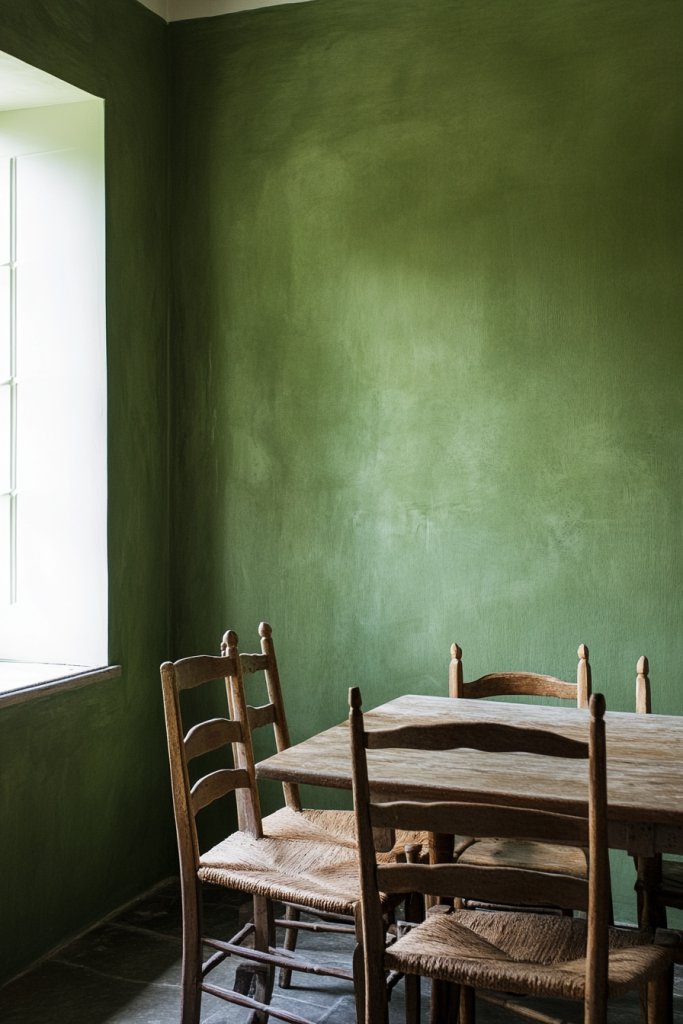
Ever find your dining space feeling a bit too sterile or uninspired? Sometimes, all it takes is a splash of calming color to turn a boring room into a haven. Green hues like moss, sage, or olive can instantly create a peaceful vibe that invites lingering conversations. If your walls are dull or mismatched, adding these tones might just be the refresh your space needs.
Imagine stepping into a dining room painted in soft sage, with natural light streaming in and bouncing off the walls, highlighting subtle color shifts. The textured walls have a matte finish, providing a gentle, soothing backdrop. Wooden accents and woven textiles complement the earthy tone, making everything feel unified and relaxed. It’s like bringing a piece of nature indoors, making every meal feel like an outdoor picnic.
You can adapt this idea seasonally by swapping out accent colors or adding removable wallpaper with green botanical patterns. For a more modern look, opt for muted, darker shades like olive or charcoal green. If your space is small, keep the color light to avoid overwhelming the room. Larger rooms can handle deeper greens for a more dramatic, cocooning effect. Mixing in textured paint or subtle metallic accents can elevate the look for a contemporary vibe.
Start by choosing high-quality, eco-friendly paint in your preferred green shade. Prepare your walls by cleaning and patching any imperfections. Use painter’s tape for clean edges and consider textured rollers or brushes for added dimension. Apply two coats for even coverage, allowing drying time between layers. If you want extra depth, incorporate a semi-gloss or satin finish to subtly catch the light. Remember, lighter greens open up a space, while darker shades add intimacy.
Add personal touches like framed quotes or artwork on your accent wall—just avoid heavy wall art that clutters the space. Incorporate natural wood furniture or woven elements to enhance the earthy feel. You could also introduce a soft cream throw blanket or cushions to break up the green and add comfort. Seasonal accessories like a cozy plaid runner or a set of textured placemats can change the vibe effortlessly.
A wall painted in calming green instantly elevates your dining experience and makes gatherings more inviting. It’s a timeless choice that works with almost any decor style, from rustic to modern. Plus, it’s easy to update with accessories or accents when your mood or trends shift. Ready to transform your space into a serene retreat that feels both fresh and grounded?
2. Use Live Succulents and Ferns as Centerpieces
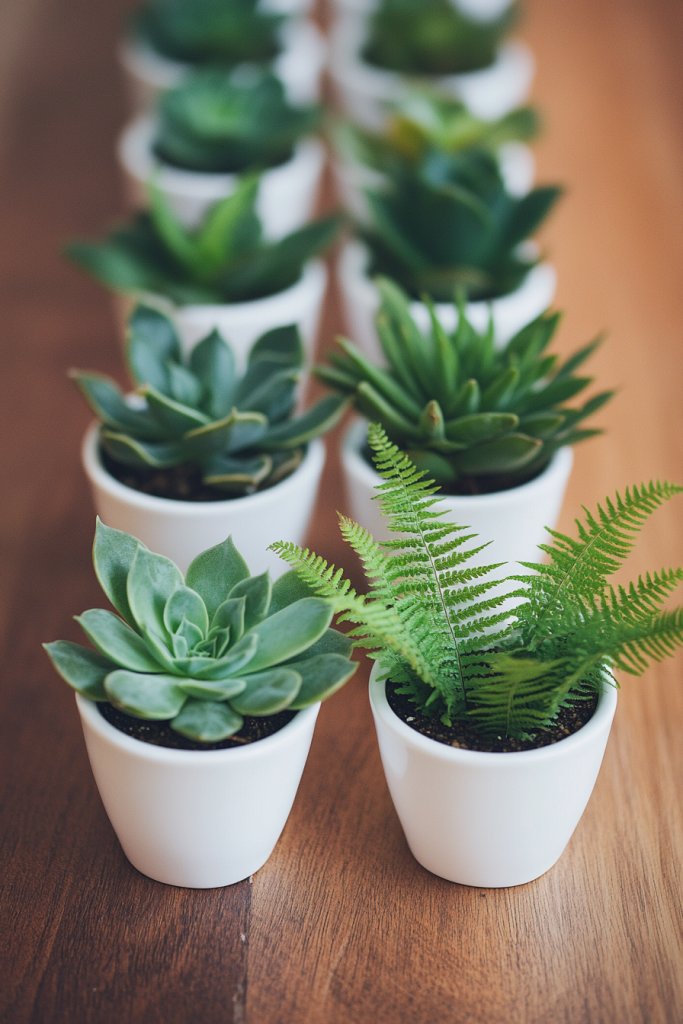
Looking to add a touch of nature without the hassle of maintenance? Traditional floral arrangements can be fleeting and high-maintenance, but succulents and ferns offer a fresh alternative. They bring a vibrant, lush feel to your table and require minimal care. Plus, they add a pop of green that brightens any dining experience.
Picture a sleek, low-profile dish filled with tiny succulents in various shades of green and gray, nestled among smooth stones. Intermixed with lush, trailing ferns spilling over the edges of vintage ceramic pots, the centerpiece feels alive and inviting. The textures vary from spiky rosettes to soft, feathered fronds, creating visual interest and a natural balance. The subtle scent of fresh soil and greenery enhances the sensory experience.
For a minimalist look, use uniform small pots in neutral colors. If your style is boho, mix and match different pots and containers for a curated, eclectic vibe. During winter, replace ferns with evergreen sprigs or holly for seasonal flair. For outdoor patios, large potted succulents can act as focal points, while small tabletop arrangements suit cozy indoor settings.
Select hardy succulents like echeveria or haworthia that thrive indoors with minimal watering. Use shallow, well-draining pots filled with cactus mix or sandy soil. Arrange your succulents and ferns in a symmetrical pattern or a freeform cluster, depending on your style. Water sparingly—once every couple of weeks—and ensure proper drainage to prevent rot. Incorporate decorative stones or sand to enhance the natural aesthetic.
Personalize your centerpieces by adding tiny labels with each plant’s name or care instructions. Incorporate small decorative items like driftwood or sculptures that complement the greenery. You can also layer different heights using small stands or trays for visual interest. For a seasonal twist, add tiny fairy lights around the pots or incorporate seasonal accents like mini pumpkins or pinecones.
Using live succulents and ferns as centerpieces keeps your table lively and fresh without much fuss. They’re budget-friendly, eco-conscious, and a conversation starter. With just a little care, they’ll thrive and continue to brighten your gatherings. Ready to bring a slice of outdoor serenity right to your dining table?
3. Layer Green Textiles with Natural Fibers for Cozy Comfort

Ever feel like your dining space is missing that warm, inviting touch? Sometimes, a simple swap of textiles can make all the difference. Layering green fabrics with natural fibers creates a cozy, tactile environment that encourages lingering over meals. If your decor feels flat or sterile, this idea offers a quick, stylish fix.
Imagine a textured jute table runner set against a soft linen tablecloth in sage. Over this, place woven placemats and napkins in earthy tones, adding depth and warmth. The tactile mix of rough jute and smooth linen invites touch and comfort. Small details like a chunky knit cushion on a nearby bench or a soft throw draped over a chair complete the cozy scene. The overall effect is relaxed, inviting, and tactile.
Switch out textiles seasonally—think lightweight cotton for summer and plush velvets for winter. Integrate different shades of green, from mint to forest, to add dimension. For a more refined look, choose natural fibers like hemp or organic cotton in neutral tones, layering with textured accents like crochet or macramé. You can also mix in patterned fabrics with botanical prints for a lively, eclectic vibe.
Start with a durable, eco-friendly tablecloth or runner in a neutral or green hue. Layer with woven placemats made from seagrass or jute, then add cloth napkins in complementary shades. Use textured or embroidered cushions on chairs or benches for added comfort. Incorporate natural fiber rugs underneath the table to anchor the space. Maintenance involves regular vacuuming or shaking out to keep everything fresh and inviting. Mix and match textiles in a way that feels natural and unforced.
Personalize by choosing fabrics with subtle patterns or embroidered details that reflect your style. Add decorative fringe or tassels to napkins or cushions for a boho touch. Incorporate seasonal elements like dried flowers or citrus slices in fabric pockets or pouches. Experiment with layering different textures until the arrangement feels cozy but balanced. These small details turn a simple dining setup into a warm retreat.
Layered textiles in shades of green make your dining area instantly cozy and stylish. They’re easy to update and mix, so your space stays fresh and inviting. Plus, natural fibers are durable and eco-friendly, aligning with sustainable living trends. Once you start layering, you’ll wonder why you didn’t do it sooner—your guests will thank you for the comfort!
4. Hang Statement Macramé Plant Holders with Indoor Greenery
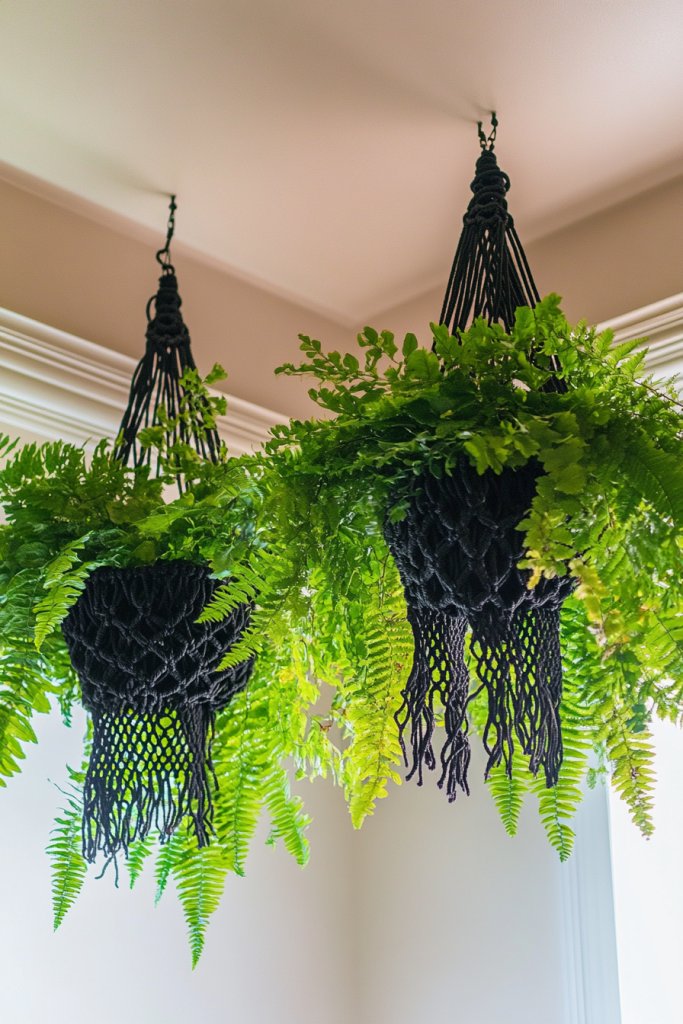
Want to add a boho-chic vibe to your dining room without cluttering the table? Hanging elements are perfect for creating visual interest and freeing up surface space. Macramé plant holders are trendy, affordable, and surprisingly easy to make or buy. They offer a stylish way to incorporate greenery indirectly, keeping your space light and airy.
Picture intricate macramé hangers in natural cotton, suspended from ceiling hooks or wall-mounted brackets. Inside each, lush greenery trails down in soft, flowing fronds, adding movement and texture. The neutral tones of the macramé contrast beautifully with the vibrant greens of the plants. The effect is both artistic and lush, giving your room a layered, textured look that feels effortlessly chic. Ambient light filters through the fronds, casting gentle shadows.
Opt for symmetrical arrangements with multiple hangers at different heights for a balanced look. For a more minimalist style, choose simple, sleek macramé with fewer knots and a monochromatic palette. During holidays or special occasions, swap greenery for faux foliage or decorative ornaments. You can also hang small baskets or lanterns alongside the plant holders for added drama or ambient lighting.
Start by selecting high-quality, sturdy cotton cords and durable hooks. Measure and cut cords to desired lengths, then knot in patterns like square or spiral knots. Insert plants with trailing or bushy growth habits—ferns, pothos, or ivy work well. Hang at varying heights to create depth and visual interest. Maintain by watering plants regularly and checking the cords for wear. For a DIY project, plenty of tutorials are available online to guide the process.
Personalize by choosing cords in your favorite neutral shades or adding beads or charms for a custom touch. Incorporate decorative weights or stones at the base of the cords for stability and aesthetic appeal. Use different plant varieties to add texture—think spiky succulents or soft mosses. Change out greenery seasonally to keep the look fresh and aligned with your mood or decor updates.
Macramé plant holders are a stylish, functional way to elevate your dining space. They’re budget-friendly and can be tailored to suit any decor style, from boho to modern minimalism. Once you master the knots, you can create a personalized hanging garden that impresses guests and lifts your space. Ready to suspend your way to a more stylish, green dining room?
5. Integrate Reclaimed Wood Furniture with Green Accents
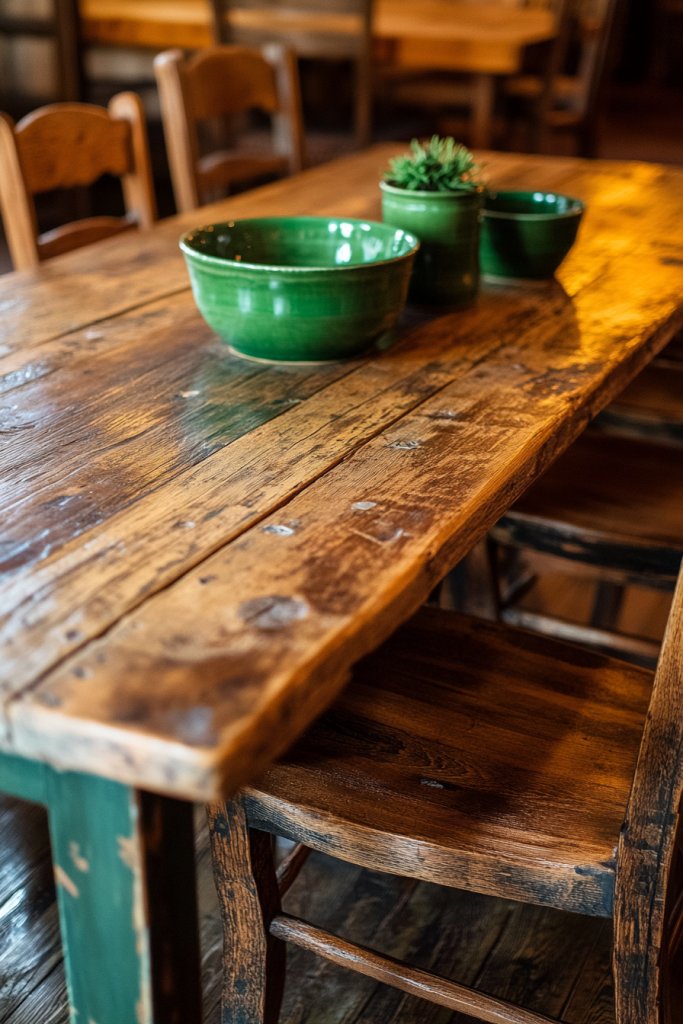
Craving a rustic yet refined look that feels authentic? Reclaimed wood furniture instantly adds character and warmth to any dining area. Paired with green accents, it creates a natural, earthy vibe that’s both stylish and eco-conscious. If your current setup feels too modern or sterile, this blend offers a grounding contrast.
Imagine a weathered reclaimed wood dining table with visible knots and grain, paired with simple green fabric cushions on the chairs. Green accents might include a set of placemats, napkin rings, or a centerpiece made from natural materials. The mix of rough-hewn wood and lush greenery creates a cozy, inviting atmosphere. The textures contrast beautifully, making every meal feel like a small retreat in nature.
Use darker, richer woods like walnut or mahogany for a more formal look, or lighter, distressed finishes for a relaxed vibe. Complement with green textiles—think velvet cushions or linen table runners. For a seasonal update, add decorative elements like seasonal foliage or candles in green holders. Smaller furniture pieces like reclaimed sideboards or shelves can also be integrated into the space for added warmth.
Source reclaimed wood from local suppliers or salvaged furniture stores. Treat the wood with eco-friendly sealants to enhance durability without sacrificing sustainability. Mix and match with modern or vintage chairs in green upholstery or painted in shades of green. Arrange your furniture to maximize space and light, keeping traffic flow in mind. Regular maintenance involves gentle cleaning and re-sealing if needed to preserve the rustic charm.
Add personal touches such as a custom-made reclaimed wood sign or etched initials. Incorporate green textiles like embroidered cushions, tablecloths, or placemats to tie the look together. Use decorative elements like vintage lanterns or ceramic ware in shades of green to elevate the aesthetic. Mixing textures and finishes keeps the space dynamic and interesting.
Reclaimed wood furniture combined with green accents creates a timeless, eco-friendly style that feels genuine and inviting. It’s a sustainable choice that adds real character and history to your space. Once finished, your dining room will radiate warmth and authenticity—perfect for both everyday meals and special gatherings. Embrace the natural, imperfect beauty of reclaimed wood and enjoy the compliments!
6. Add Green Glassware and Tableware for a Fresh Look
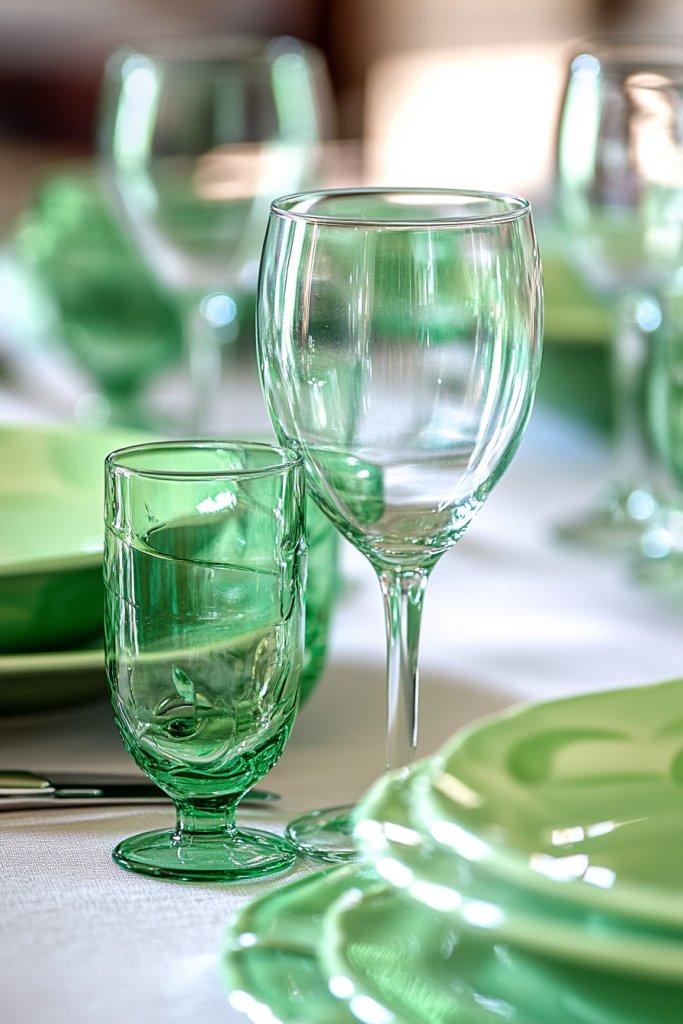
Tired of the same old dinnerware that feels uninspired? Adding green glassware and tableware instantly refreshes your table setting with a splash of color. It’s a simple upgrade that elevates your dining experience while keeping things playful and elegant. Plus, it’s a fun way to incorporate green without overwhelming the space.
Picture a set of emerald or jade-colored glasses catching the light, paired with matching plates and bowls. The glossiness of the glass contrasts beautifully with matte or textured placemats, adding depth. Greenware can be used for everything from casual brunches to formal dinners, creating a cohesive look. Small details like a green teapot or serving platter tie the theme together, making every meal feel special.
Mix different shades of green for a layered, eclectic look or stick to a single tone for sleek uniformity. Incorporate vintage glassware for a nostalgic vibe or opt for modern, geometric designs. During holidays or themed dinners, swap in seasonal colors like deep forest green or bright lime. For outdoor gatherings, durable, shatterproof green tableware adds practicality without sacrificing style.
Select high-quality glassware that fits your needs and budget—consider lead-free options for safety. Coordinate with your existing table linens and accessories to create a harmonious look. Use matching or complementary green dinnerware for a polished appearance, or mix and match for a more casual, eclectic style. Store your glassware carefully to prevent chips or cracks. Incorporate stacking or tiered serving trays in green for practical and attractive presentation.
Personalize your tableware with monograms or painted accents for special occasions. Add small decorative touches like green napkin rings or placemats with botanical prints to complete the look. Use themed accessories—think tiny herb pots or mini terrariums—to amplify the green theme. Keep a few statement pieces, like an ornate green decanter, for eye-catching moments during gatherings.
Green glassware and tableware give your dining setup a fresh, vibrant feel that impresses guests. They’re versatile, stylish, and easy to switch out for different seasons or occasions. Once you incorporate these elements, your table will look more inviting and thoughtfully curated. Cheers to elevating every meal with a splash of green!
7. Install Green-Toned Pendant Lighting for Ambient Glow
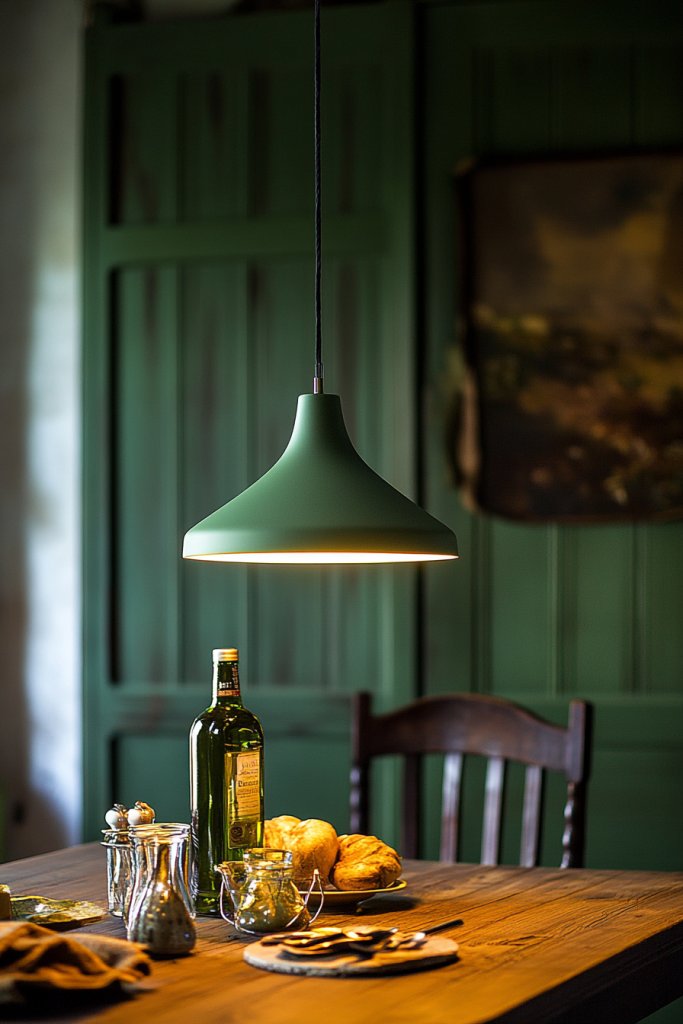
Want to create a warm, inviting atmosphere that feels both modern and natural? Lighting plays a crucial role in setting the mood, and green-tinted fixtures add a unique, subtle flair. It’s a small change that makes a big impact, transforming your dining experience from functional to magical. If your current lighting is flat or harsh, consider this as a stylish upgrade.
Imagine hanging pendant lights with softly tinted green glass shades that diffuse warm light over the table. The glow casts a gentle hue, enhancing the earthy palette of the room. The natural materials like bamboo or rattan used for shades add texture, blending seamlessly with wood and textiles. This ambient light creates cozy pools of warmth, perfect for intimate dinners or lively gatherings.
Choose shades in different green tones—olive, jade, or mint—to match your room’s vibe. For a contemporary look, opt for sleek, geometric fixtures with a matte finish. During seasonal updates, swap out shades for colored fabric or paper for a playful touch. For larger spaces, cluster multiple fixtures at varying heights for visual interest or stick to a single statement piece for simplicity.
Select pendant fixtures that suit your style and space—consider size, scale, and finish. Install wiring and ceiling hooks securely, following safety protocols. Use LED bulbs with warm color temperatures to enhance the green-tinted shades without overpowering. Consider dimmer switches for adjustable ambiance. Carefully position the fixtures to ensure even light distribution without glare or shadows.
Add decorative elements like woven cords or fabric wraps around the fixtures for texture. Incorporate complementary accents such as green ceramic or wooden details nearby. For a more organic look, choose fixtures with natural, unfinished finishes. Seasonal or thematic wraps can be added to switch up the style for holidays or special occasions.
Green-toned pendant lighting elevates your dining room’s ambiance with a subtle, stylish touch. It’s a simple DIY upgrade that instantly adds character and warmth. Once installed, you’ll love how it transforms your space into a cozy oasis perfect for meaningful meals and conversations.
8. Incorporate Natural Fiber Rugs in Shades of Green
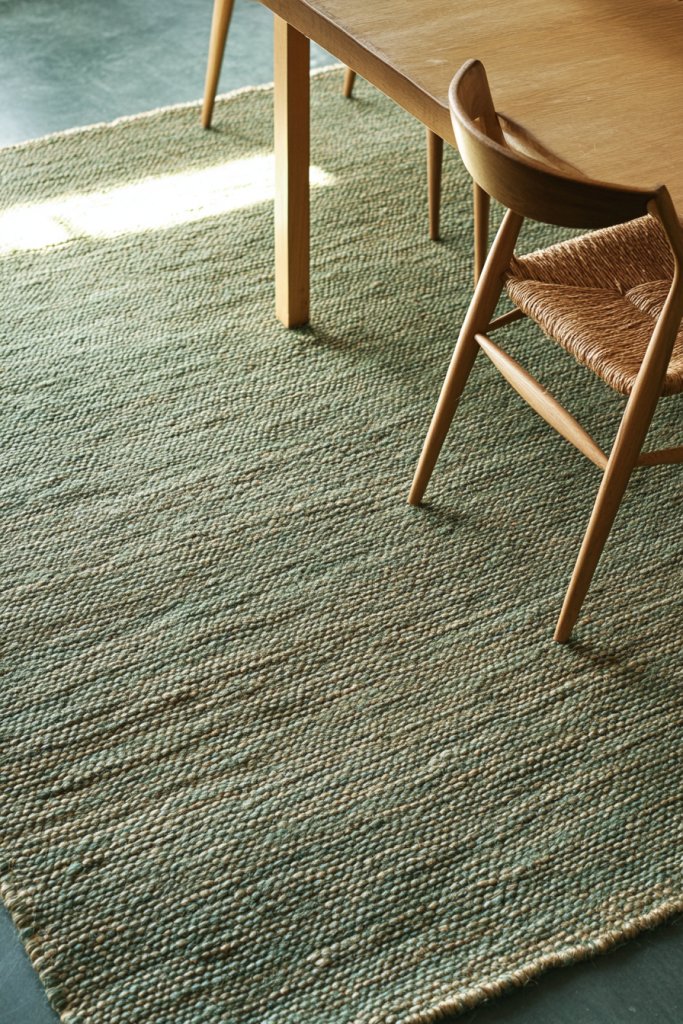
Does your dining area lack warmth and texture? A well-chosen rug can anchor your space and add tactile interest that makes everyone want to kick off their shoes. Natural fiber rugs in shades of green bring earthy charm and durability, making your room feel more inviting. If your floors feel cold or plain, this is a quick fix that upgrades style and comfort.
Visualize a woven rug in lush green hues—perhaps in jute, sisal, or seagrass—laid beneath your dining table. The textured surface adds depth and a natural feel, contrasting beautifully with smooth tableware and sleek furniture. The fibers catch the light, highlighting their organic irregularities, while the earthy tones complement the green walls or accents. It’s a raw yet refined foundation for your entire dining setup.
Choose lighter shades of green for a subtle, understated look or richer, deeper greens for a statement piece. Layer rugs for a more eclectic, boho vibe or keep it simple with a single large piece. For seasonal updates, add a woven runner or small mats with different textures or patterns. Outdoor or covered patios can benefit from larger, more rugged designs for durability and style.
Select a natural fiber rug that’s appropriately sized for your space—at least slightly larger than your table. Ensure it has a non-slip backing or add a rug pad for safety. Regularly vacuum or shake out the fibers to remove dust and dirt. For outdoor rugs, choose weather-resistant materials. Keep spills contained and clean promptly with mild soap and water to preserve the fibers’ integrity.
Personalize with decorative trim or fringes, or add small accents like seasonal herbs or dried flowers placed on the rug edges. Use coordinating textiles—such as green placemats or cloths—to create a cohesive look. Incorporate subtle color variations within the green spectrum for added interest. Consider layering with a smaller, patterned mat for a personalized, layered aesthetic.
A natural fiber rug in green grounds your dining space with organic elegance. It’s functional, eco-friendly, and easy to maintain, making it a practical choice for everyday life. Once you see how it elevates your decor, you’ll wonder why you waited so long. Plus, it’s a versatile base that pairs beautifully with any style, from rustic to contemporary.
9. Decorate Walls with Botanical Prints and Nature-Inspired Art
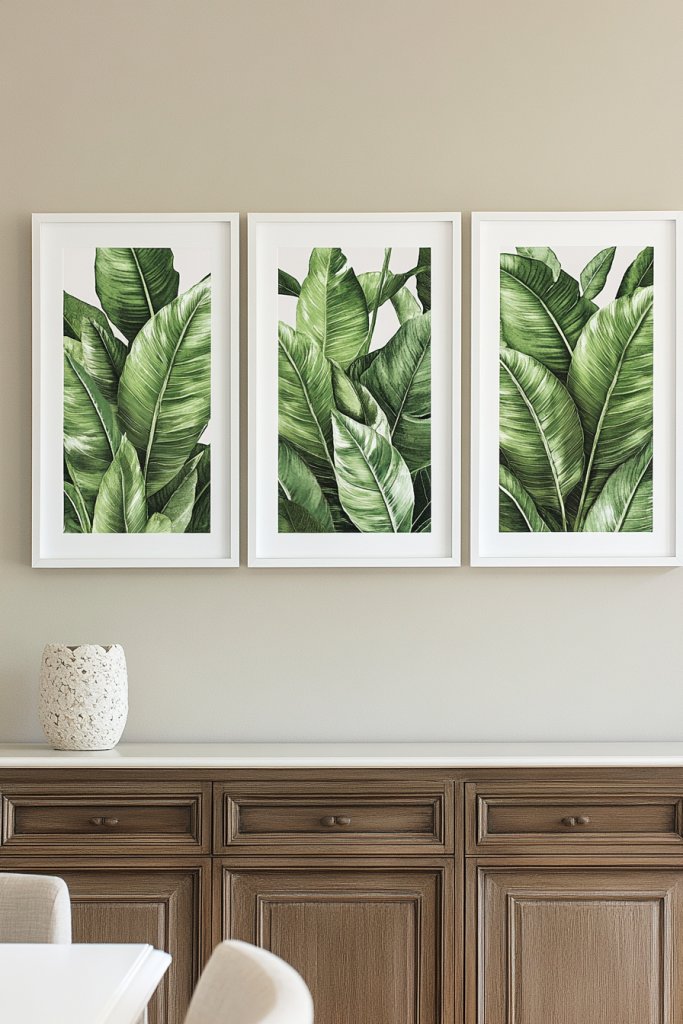
Feeling like your walls are missing that finishing touch? Botanical prints and nature-inspired art add instant personality and depth without cluttering your space. They serve as focal points that reinforce your green theme and bring a breath of fresh air into the room. If your walls are plain or overly busy, carefully chosen art can tie everything together.
Visualize framed prints of lush leaves, abstract green landscapes, or detailed botanical illustrations hung in a gallery wall layout. The frames might be natural wood or sleek black, depending on your style. These artworks add layers of interest and invite a closer look, turning your walls into a mini nature museum. The green tones within the prints complement your overall color scheme, creating harmony and calm.
Mix different styles—vintage botanical drawings, modern abstract art, or photographic prints of nature scenes. For a cohesive look, stick to a consistent color palette within the green spectrum. Change your art seasonally by swapping prints or framing new pieces to keep your space fresh. Large-scale pieces work well as statement focal points, while smaller prints can create a curated gallery.
Choose prints that resonate with your personal style—consider both size and framing. Use wall hooks, nails, or adhesive strips for easy installation. Arrange your artwork in a symmetrical grid or an organic, asymmetrical layout for visual interest. Protect your prints with UV-resistant glass or acrylic if they’ll be exposed to sunlight. Regularly dust or clean the frames to keep the display looking fresh.
Create a themed collection by grouping similar objects or artworks—think leaves, floral motifs, or abstract greens. Use mats in contrasting or matching colors to enhance visual impact. Incorporate small decorative elements like metallic accents or textured mats for added sophistication. Personalize with handwritten quotes or labels that reflect your connection to nature.
Decorating with botanical prints transforms blank walls into artful expressions of your love for nature. It’s an affordable way to add color, interest, and personality. Once you start curating your collection, your space becomes a reflection of your style and mood. Ready to turn your walls into a green sanctuary?
10. Use Green-Tinted Candles and Lanterns for Soft Illumination
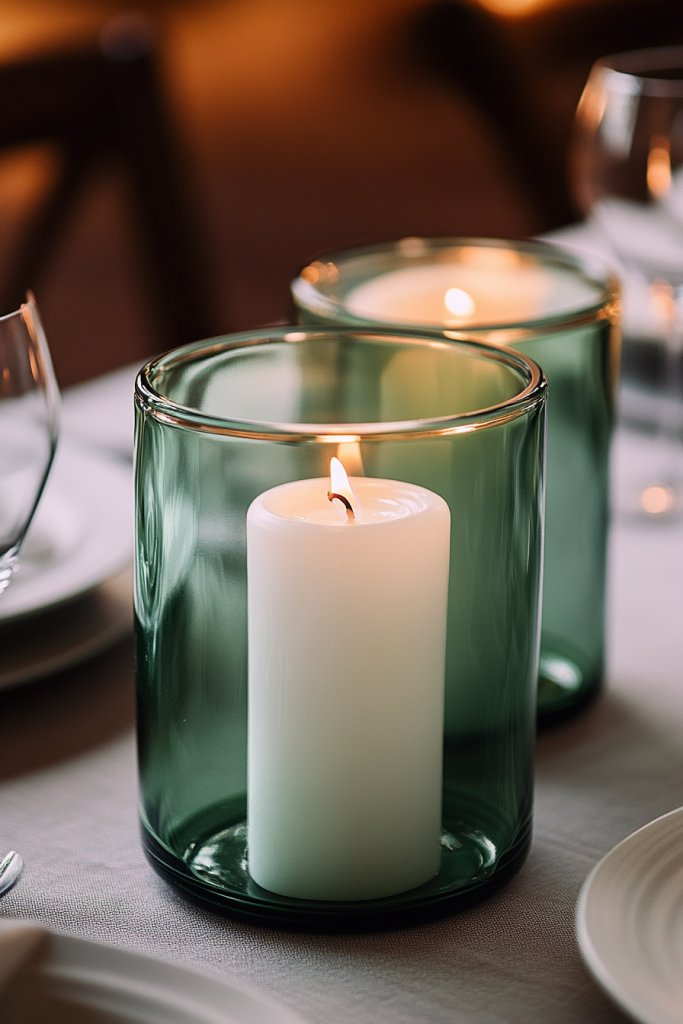
Want to create a cozy, intimate atmosphere without investing in expensive lighting? Green-tinted candles and lanterns provide soft, ambient glow that elevates any dining space. They add a touch of elegance and calm, perfect for relaxing meals or lively parties. If your current lighting feels too harsh or uninspired, this simple change can make a huge difference.
Imagine a cluster of green glass lanterns with flickering candles lining your table or hanging from hooks. The gentle glow casts warm, greenish hues that dance across the walls and tableware. The glass reflects the flickering light, adding a shimmering effect that enhances the cozy vibe. Small decorative details like textured candle holders or ornate lanterns add a layer of sophistication and charm.
Choose lanterns in different shapes and sizes for a layered look, or keep it minimal with a few statement pieces. During festive seasons, swap plain candles for scented or colored ones to match your theme. For outdoor dining, weatherproof lanterns with LED candles offer safety and durability. Incorporate metallic accents like brass or copper for a modern touch.
Select candles or lanterns that suit your aesthetic—think frosted green glass, vintage metal, or sleek ceramic. Place them strategically along your table, on sideboards, or hanging from ceiling hooks. Use flameless LED candles for safety and longevity, especially if you have children or pets. Dim your main lights to allow the candles’ glow to create the perfect ambiance. Keep wicks trimmed and replace candles when they burn down.
Add decorative elements like dried herbs, small crystals, or seasonal accents inside lanterns for a personalized touch. Incorporate scented candles to bring in subtle fragrances that enhance the dining experience. Use different heights and styles to create visual interest and depth. You can also string fairy lights in shades of green for a whimsical, enchanted effect.
Green candles and lanterns are a simple, affordable way to add warmth and charm to your dining space. They’re versatile and easy to update for every season or mood. The soft glow encourages relaxed conversations and memorable moments. Ready to light up your space with a touch of natural elegance?
11. Create a Green Focal Point with a Living Wall or Vertical Garden
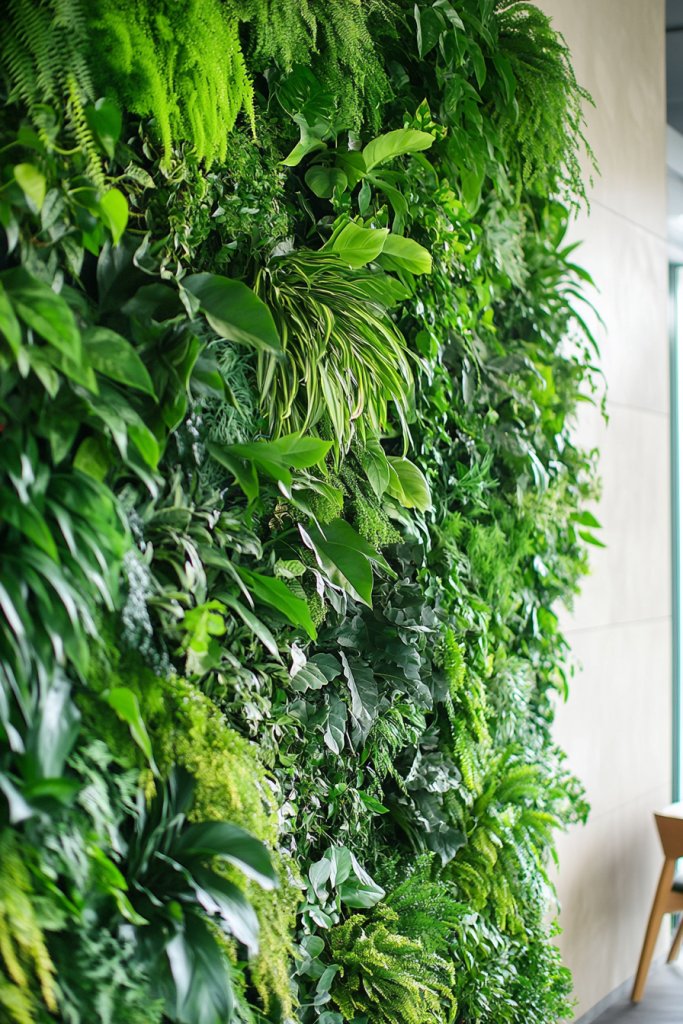
Looking for a bold way to make your dining room stand out? A living wall or vertical garden provides an impressive focal point that’s both eye-catching and refreshing. It’s an innovative way to bring lush greenery indoors, especially if space is limited. If your walls feel empty or uninspired, this feature will turn your room into a statement piece.
Visualize a framed vertical garden filled with a variety of hardy, low-maintenance plants arranged in an artful pattern. The greenery cascades down in different shades and textures, creating a wall that feels alive. The natural light accentuates the lushness, while the subtle scent of fresh foliage fills the room. This living artwork becomes a conversation starter and a natural backdrop for your meals.
Choose modular plant panels or framed plant arrangements for flexibility. During different seasons, swap out or add plants to change the look. For a more formal aesthetic, use symmetrical designs with container plants in matching pots. For a casual or eclectic style, mix different plant types and containers for a layered, organic feel.
Install a sturdy frame or wall-mounted system designed for vertical gardens. Select low-maintenance, air-purifying plants like pothos, ferns, or succulents—just avoid high-humidity or overly demanding varieties. Use organic soil or hydroponic systems for easy maintenance. Ensure your lighting setup supports plant growth, with grow lights if necessary. Regular watering, pruning, and fertilizing keep the wall lush and healthy.
Incorporate decorative elements like small sculptures or stones among the plants for added visual interest. Frame your living wall with natural wood or metal accents to match your decor. Use personalized plant labels or small signs to identify different species. Seasonal flowers or colored foliage can be integrated to keep the display fresh and engaging.
A living wall transforms your dining space into a green paradise that’s as functional as it is beautiful. It’s a modern, eco-conscious feature that adds value and character. Once established, it requires minimal upkeep and offers ongoing satisfaction. Prepare to impress guests with your lush, vibrant centerpiece—your own indoor garden masterpiece.
12. Incorporate Natural Materials in Table Settings
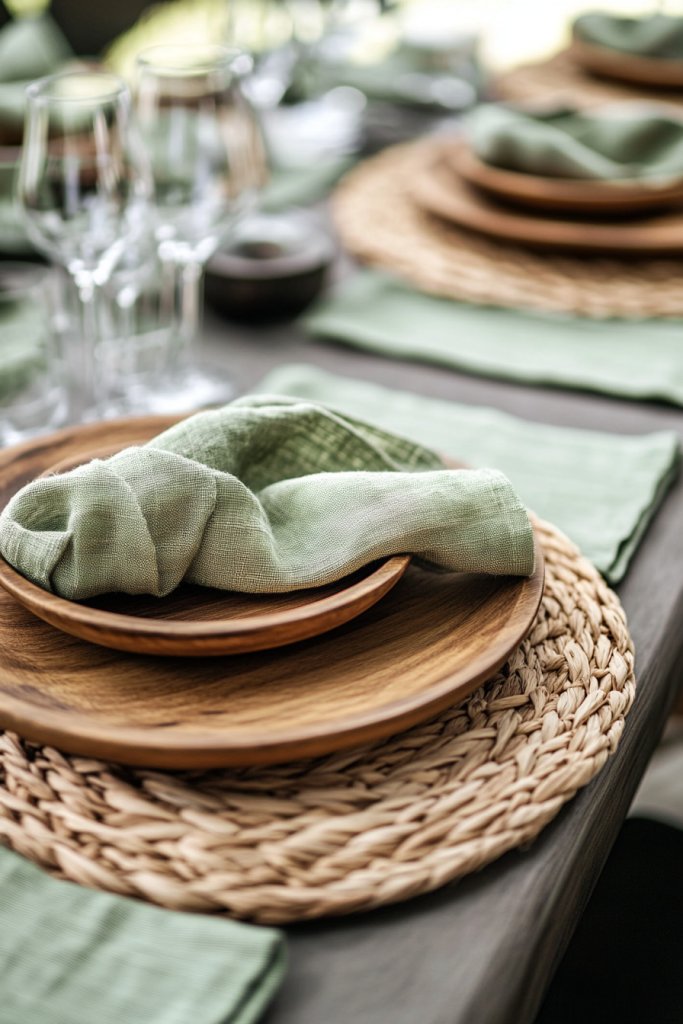
Ever tried hosting a dinner where everything feels a bit too sterile or overly polished? Sometimes all it takes to warm up a space is a dash of natural charm. Using natural materials in your table settings instantly adds a cozy, authentic vibe that invites guests to relax and enjoy. Plus, it’s a simple way to make your dining area feel more grounded and connected to nature.
Picture a rustic wooden charger plate paired with a handcrafted ceramic plate, both with earthy tones and textured surfaces. Imagine linen napkins with frayed edges sitting atop bamboo placemats, while a stoneware pitcher holds fresh water or juice. The tactile mix of rough and smooth textures creates an inviting visual contrast that makes the table feel organic and genuine. Candles or small wooden accents can add warmth without overpowering the natural theme.
This look adapts beautifully to both modern and rustic styles—think sleek, minimalist wooden chargers for contemporary spaces or rough-hewn, reclaimed wood for a farmhouse vibe. Seasonal variations include adding seasonal foliage or edible herbs directly on the table for a fresh, edible touch. You can swap out materials based on your budget or availability, like using woven jute or cork instead of high-end hardwood. The key is maintaining the earthy, unrefined aesthetic.
Start by sourcing natural materials such as wooden chargers, bamboo utensils, and stoneware plates from local artisans or eco-friendly brands. Focus on pieces with organic textures and imperfect finishes that highlight their handcrafted nature. Mix and match different materials to add depth, but keep a cohesive color palette—think warm browns, muted greens, and soft creams. Incorporate cloth napkins made from linen or cotton, and consider using biodegradable or reusable placemats. Assembling the table is about balancing textures and tones for that effortless, natural look.
Personalize your table by adding small touches like custom engraved wooden coasters or hand-painted ceramics. Incorporate edible accents like sprigs of thyme or rosemary as natural garnishes, which also add aroma and flavor. You can even include handmade pottery pieces or vintage finds to tell your personal story. Layering different textures and materials allows you to create a unique, curated feel that reflects your style.
Embracing natural materials in your table setting elevates your hosting game while keeping things authentic and eco-conscious. It’s a versatile approach that works for casual brunches or more formal dinners. Once you get the hang of mixing textures and materials, you’ll find it’s surprisingly easy to craft a beautiful, inviting table—no fancy decor required. Your guests will love the relaxed, earthy vibe that makes every meal feel like a special occasion.
13. Add Green Accents with Decorative Bowls and Vases
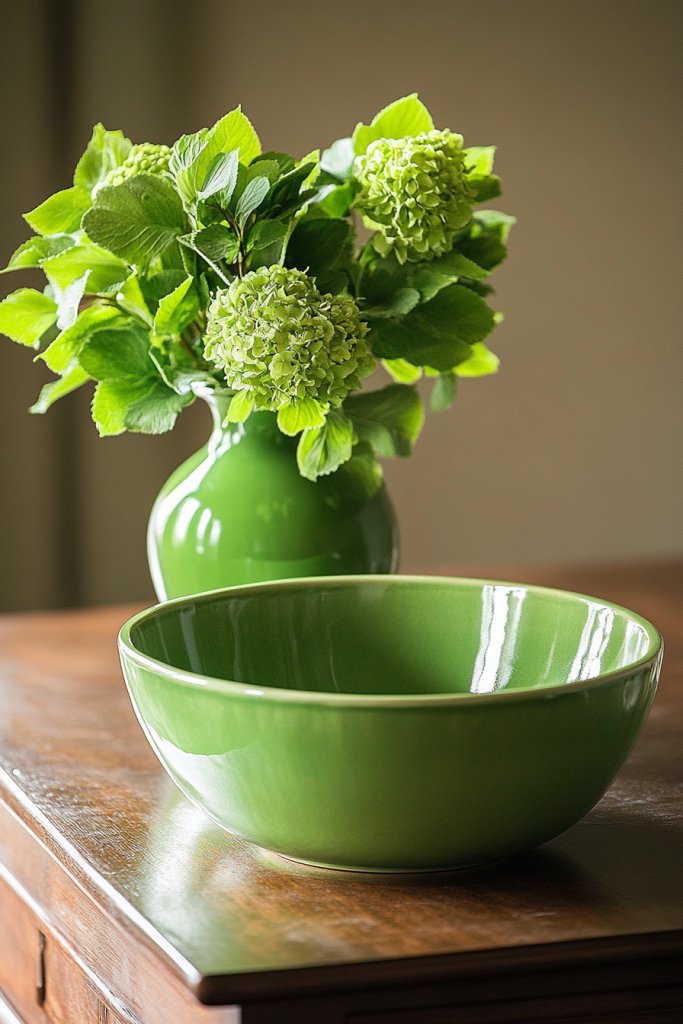
Tired of your dining table looking a bit flat or uninspired? Sometimes, all it takes to give it a fresh boost is a simple decorative bowl or vase filled with vibrant accents. These little touches can transform the entire look and feel of your setup without much effort. Plus, they’re perfect for adding a splash of color or texture that complements your green theme.
Imagine a sleek ceramic bowl in deep jade sitting at the center of your table, filled with seasonal fruits or colorful faux foliage. Or picture a tall, textured vase with a narrow neck, holding a few sprigs of dried herbs or decorative twigs. These accents add visual interest and create focal points that draw the eye, making your table feel curated and thoughtfully styled. The contrast of glossy and matte surfaces adds depth and dimension.
Decorative bowls and vases come in endless styles—minimalist, boho, vintage, or modern. Change the contents seasonally, from fresh herbs and flowers in spring to dried botanicals in winter. You can also experiment with different heights and shapes to add visual variety, or cluster smaller items for a layered effect. For smaller spaces, opt for compact bowls or narrow-neck vases that don’t overcrowd the table.
Choose bowls and vases made from natural materials like ceramic, terracotta, or recycled glass for an eco-friendly vibe. Fill them with fresh or faux greenery, seasonal foliage, or even decorative stones or beads for added texture. Mix different sizes and shapes to create a balanced display. Place them strategically at the center or use them as accent pieces on sideboards or shelves. Refresh contents regularly to keep the look vibrant and interesting.
Add a personal touch by customizing your bowls and vases—paint them with patterns or initials, or incorporate meaningful objects like small keepsakes or souvenirs. Use colors that harmonize with your overall decor palette for a cohesive look. Incorporate themed accents such as shells, pinecones, or mini sculptures to reflect your style or season. These small tweaks make your table more personalized and inviting.
Decorative bowls and vases are easy, cost-effective ways to elevate your table decor. They allow you to experiment with colors, textures, and contents without committing to large or expensive pieces. Over time, you’ll develop a knack for creating balanced, eye-catching displays that impress guests. Remember, sometimes less is more—simple accents can make a big impact.
14. Use Green-Tinted Window Treatments for a Fresh Atmosphere
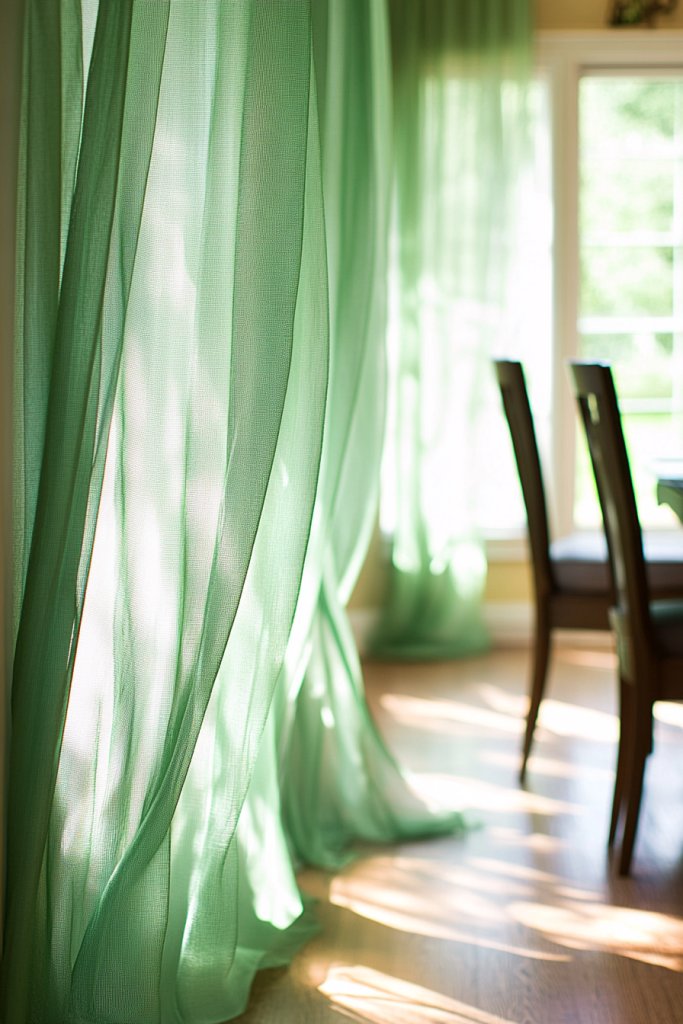
Feeling like your dining area is missing that fresh, airy vibe? Window treatments in shades of green can instantly brighten up the space and bring in a calming, natural feel. They filter light beautifully and subtly tie your entire room into the green theme. Plus, they’re a simple upgrade that can change the mood of your space without a full overhaul.
Picture sheer, moss-colored curtains gently billowing with the breeze, creating a soft, diffused glow. Or imagine botanical-patterned blinds in shades of sage and olive that add subtle visual interest when drawn. These treatments add layers of color and texture, making the room feel more vibrant and alive. The way light filters through textured fabrics adds a cozy, inviting atmosphere perfect for intimate gatherings.
Choose from a variety of window coverings—flowy curtains, Roman shades, or bamboo blinds—each offering a different aesthetic and level of privacy. Seasonal options include lighter fabrics for summer and heavier, insulating materials for winter. Incorporate patterns like leaves or vines to reinforce the natural theme. Adjust the opacity and length depending on your window size and desired light control.
Start by selecting fabrics or materials in shades of green that match your decor. Measure your windows carefully to ensure a perfect fit. Hang curtains on decorative rods that complement your style—think matte black, brushed gold, or natural wood finishes. For blinds or shades, choose eco-friendly options like bamboo or recycled fabrics. Installing these treatments is straightforward but ensure secure mounting for safety and durability.
Add extra flair with tiebacks or decorative tassels in complementary colors. Layer curtains with sheer panels for added dimension or pair with textured blinds for depth. Use fabric-dyeing techniques or DIY embellishments to customize plain treatments. To create a more immersive experience, coordinate your window treatments with your table linens or wall decor.
Green-tinted window treatments are a subtle yet powerful way to refresh your dining space. They offer a versatile, low-cost way to enhance mood and ambiance. Once you see how a simple change in fabric and color transforms the room, you’ll be motivated to experiment further. It’s an easy step toward creating a cohesive, nature-inspired environment that feels just right.
15. Incorporate Eco-Friendly, Green-Inspired Art Pieces
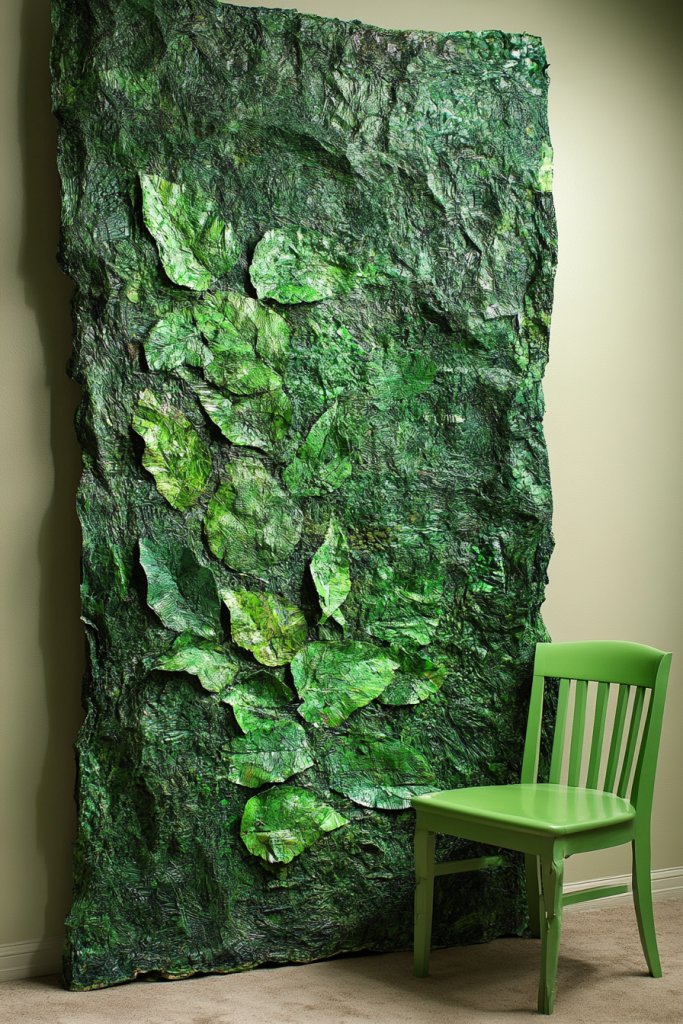
Are you craving a more artistic, personalized touch to your dining area? Eco-friendly art pieces inspired by nature can make a bold statement while aligning with your green theme. They add character and depth without cluttering or overwhelming the space. Plus, choosing recycled or sustainable materials keeps your decor eco-conscious and stylish.
Imagine a sculpture crafted from reclaimed metal or a wall-mounted piece made from recycled wood, depicting leafy patterns or abstract nature scenes. Visualize a set of handcrafted prints featuring green landscapes or botanical motifs, printed on recycled paper. These elements create a layered, textured backdrop that reflects your love for the environment and art. The combination of textures and natural tones adds warmth and personality.
Choose between sculptures, wall hangings, or framed prints, depending on your style and space constraints. Incorporate mixed media art with natural fibers or recycled plastics for a contemporary look. For a more subtle approach, opt for small decorative objects that can sit on shelves or sideboards. Rotate your art periodically to keep the space fresh and engaging.
Start with art pieces made from recycled or sustainably sourced materials—look for local artisans or eco-label brands. Hang artwork at eye level for maximum impact, using eco-friendly adhesives or mounting hardware. Mix different styles and materials to create visual interest—think woven textiles, metal sculptures, and printed canvases. Ensure your art complements existing decor and enhances the natural vibe.
Create your own art by upcycling materials—use old fabric scraps, natural dyes, or repurposed wood. Personalize your pieces with meaningful symbols or initials. Incorporate thematic elements like leaf patterns, animal motifs, or abstract landscapes in your color palette. Display your collection prominently to make your space uniquely yours.
Eco-inspired art not only beautifies your space but also reinforces your commitment to sustainability. It’s a creative way to express your values and style simultaneously. As you curate your collection, you’ll gain confidence in blending artistry with eco-consciousness, inspiring others to do the same. Your space becomes a reflection of your passion for nature and design.
16. Arrange Green-Lined Serving Trays for a Cohesive Look

Ever notice how serving food on mismatched or plain trays can break the visual flow of your table? Green-lined serving trays introduce a unified, elegant touch that ties everything together. They create a sense of harmony and sophistication, making your presentation look effortless yet curated. Plus, they add just a hint of color that boosts the overall ambiance.
Imagine a set of sleek, rectangular trays with a deep emerald lining, contrasting beautifully with natural wooden handles. Visualize stacking different sizes of trays, each with green accents, for serving appetizers or desserts. The subtle pop of color complements fresh produce or artisanal snacks, elevating your presentation. When not in use, they stack neatly, adding to your decor while keeping things organized.
Choose trays with various shapes—round, rectangular, or oval—to suit different dishes and occasions. Opt for materials like bamboo, reclaimed wood, or eco-friendly plastics that align with your sustainability goals. Use different shades of green—olive, jade, or mint—to match your decor palette. For seasonal flair, consider adding decorative borders or patterns that can be swapped out.
Select trays with durable, eco-friendly materials that are easy to clean. Use non-slip pads or stands to prevent slipping during serving. Coordinate the lining color with your table linens for a seamless look. When serving, arrange dishes thoughtfully on the trays to highlight colors and textures. Store trays vertically or stack them neatly for quick access and space-saving storage.
Personalize your trays by adding monograms, decorative decals, or painted accents. Mix and match with other serving pieces that have green details for a cohesive aesthetic. Use them to serve signature cocktails or themed snacks that match your decor. You can also create custom liners or covers for special occasions, adding an extra personal touch.
Green-lined serving trays bring a polished, unified look to your gatherings, boosting your confidence as a host. They subtly reinforce your green theme and showcase your attention to detail. As you experiment with different styles and colors, you’ll develop a signature look that impresses guests and elevates everyday meals to special occasions. It’s a simple upgrade with a big visual payoff.
17. Add Small Green Accents with Nature-Inspired Accessories
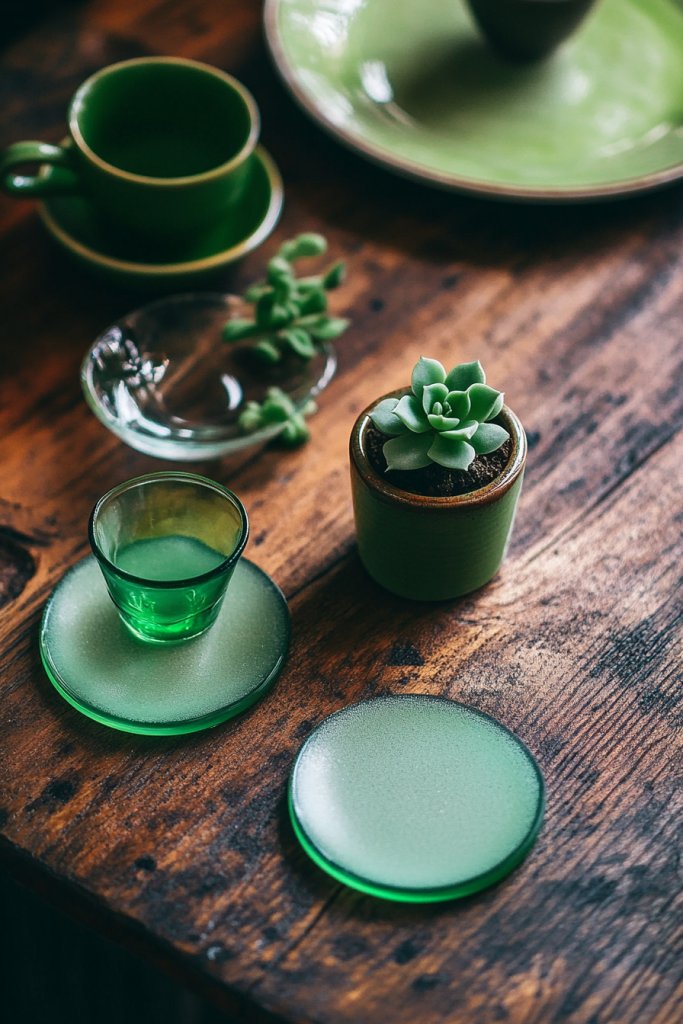
Sometimes, the smallest details make the biggest difference. Want to subtly reinforce your green dining room theme without overdoing it? Tiny accents inspired by nature provide a delicate, sophisticated touch. They’re perfect for adding visual interest and can be easily swapped or updated as your style evolves.
Imagine leaf-shaped coasters in soft ceramic resting under your glasses or small, textured green ceramic figurines placed along the table. Visualize natural fiber placemats or napkin rings, subtly tying everything together. These small details create a layered, textured look that feels organic and thoughtfully curated. They also add tactile interest, making every element on the table inviting.
Mix and match different textures—think matte ceramics, woven fibers, and smooth wood—to create a dynamic visual story. Incorporate seasonal motifs like acorns or pinecones in winter or flowers in spring for thematic consistency. Use subtle colors—muted greens, taupe, or beige—to keep the look cohesive. These accents work well on side tables, bread stations, or as part of place settings.
Source small accessories from eco-friendly or handmade collections, or craft your own using clay or natural fibers. Place them thoughtfully—stacked in bowls, spread along the table, or clustered on sideboards. Keep the accessories proportionate to the space to avoid visual clutter. Regularly update or rotate these accents to keep the decor feeling fresh. Incorporate them into your existing theme seamlessly for a polished look.
Create custom accessories with personal touches—engraved initials on coasters or hand-painted motifs on small sculptures. Use natural materials like cork or sisal for placemats, or add small potted herbs in biodegradable containers. These tiny details can reflect your personality and make your space uniquely yours. Incorporate meaningful symbols or colors that resonate with your style.
Small, nature-inspired accents are an easy way to tie your entire room together effortlessly. They add depth without overwhelming, making your decor appear intentional and well-thought-out. As you experiment with different pieces, you’ll gain confidence in curating a cohesive, inviting space that subtly celebrates nature and style. These little touches elevate your everyday dining experience.
Conclusion
Exploring these diverse green dining room ideas reveals just how versatile and inspiring this color can be in transforming your space. Whether you prefer bold, statement pieces or subtle, soothing accents, there’s a style here to suit every taste. Don’t hesitate to try out these ideas and make your dining area a true reflection of your love for nature. Embrace the change and enjoy creating a beautiful, inviting space for all your gatherings!
